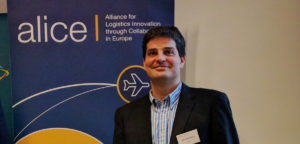On the occasion of concluding the first phase of Vital Nodes Workshops, we interviewed Fernando Liesa, Secretary General of the European Technology Platform ALICE about his views on the integration of urban nodes. ALICE is set-up to develop a comprehensive strategy for research, innovation and market deployment of logistics and supply chain management innovation in Europe.
 How do you think the TEN-T Network will impact the urban nodes? Where do you see the greatest challenges for the development of urban nodes?
How do you think the TEN-T Network will impact the urban nodes? Where do you see the greatest challenges for the development of urban nodes?
TEN-T network will indeed be core for cities development. From a logistics perspective, TEN-T network will help full connectivity and access for inbound goods to urban nodes were they are mostly consumed but also for outbound goods stored or manufactured in the (or close to) urban areas and later distributed at European or global scale. Making a comparation to the human body, TEN-T network are the core veins and arteries through which goods are transported for people consumption in vital organs for European society, welfare and economy, the urban nodes. Following the example, the challenge is to get and homogeneous and truly integrated system. Urban nodes that can adapt an easily connect to the TEN-T network and develop proper urban (and peri-urban) logistics system to make it easy and sustainable to access the goods will succeed. The actual and most difficult challenge is to get urban nodes to differentiate which are particularities of the urban node and what is not. Definitely, the cost for logistics (and citizens) to handle particularities will be higher than to handle common/similar city logistics systems. Moreover, facing common challenges such as emission reductions, etc. will be more effectively addressed from an integrated approach.
What would be important measures to improve the efficiency of urban nodes? Which measures could contribute to efficient and sustainable logistics.
As we already discussed and agreed in our “Collaborative Innovation Day” on City Logistics with our stakeholders, cities and urban nodes need to work on having a better picture of how goods are moved, consumed and even produced from and to the urban node, where are the main transport/ logistics infrastructures and develop the urban node logistics system accordingly and implement Sustainable Urban Logistics Plans. Do urban nodes have a way to measure the EFFICIENCY of the assets delivering their urban area? Do they have an idea about it? We know that efficiency is key to meet the decarbonisation objective at an affordable cost. You get what you measure, so the first measure should be to have a full understanding of this
ALICE developed a comprehensive roadmap for research and innovation in logistics and freight transport. How do the proposed intervention areas relate to the development in the urban nodes of the TEN-T network.
Urban nodes are critical as are the final destination of most of goods. Moreover, urban nodes are mostly contributing to most of emissions including CO2 which is one of the main challenges we need to face. Although CO2 is low in the urban nodes agenda (as other pollutants are much more important for the health of people) they are main contributions so an European agenda on this subject can not be isolated of the urban nodes agendas. For us, a smart and successful urban node need to be able to manage properly the needs of the citizens while ensuring the less possible impact to society. Urban nodes in the TEN-T network need to leverage the potential of being in such a privileged position.
Talking about bringing logistics into urban planning, how can urban areas ensure that freight planning integrates well with the policy goals.
Some ideas have already being shared on this in previous questions but the premise is that freight planning is at the core of the city development and seen as a tool to meet the policy goals. To achieve that, an holistic approach considering the value of freight transport and logistics for the city is needed.
Vital Nodes aims to approach all 88 nodes of the TEN-T network. What would be key question you would like to ask all these nodes?
I would ask them what they think is particular for them as a node and what they think they mostly share with others. Based on that, solutions and approaches could be built fitting most of the nodes and making then easier to progress due to economies of scale for freight transport and logistics operators and cargo owners. As I said, managing particularities and specificities of the nodes should be out of the scope or not prioritized in a project targeting TEN-T Network and Urban Nodes. Moreover, I would ask if they know which are the 3 top nodes that mainly exchange with? Have they matched practices? Are thinking about converging measures and systems for a more seamless operation? Standardization is key, but difficult to own…but aligning with your key partners should come natural and is much more in control of stakeholders.